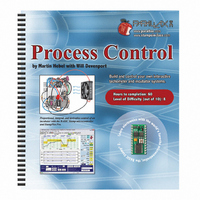122-28176 Parallax Inc, 122-28176 Datasheet - Page 7

122-28176
Manufacturer Part Number
122-28176
Description
GUIDE STUDENT PROCESS CONTROL
Manufacturer
Parallax Inc
Specifications of 122-28176
Accessory Type
Manual
Product
Microcontroller Accessories
Lead Free Status / RoHS Status
Contains lead / RoHS non-compliant
For Use With/related Products
Propeller Education (PE) Kit
Lead Free Status / RoHS Status
Lead free / RoHS Compliant, Contains lead / RoHS non-compliant
- Current page: 7 of 330
- Download datasheet (11Mb)
Preface · Page iii
Preface
Industrial process control (PC) is a fascinating and challenging area of electronics
technology and nothing has revolutionized this area like the microcontroller. The
microcontroller has added a level of intelligence to the evaluation of data and a level of
sophistication in the response to process disturbances. In this respect, you may hear that
microcontrollers are embedded as the “brains” in much of our manufacturing equipment
and consumer electronic devices. But in reality, the real “brains” of the system is the
process control technician.
Although embedded process control centers around the microcontroller, it is only one
piece of the total control system. The process control technician must be part control
engineer, electronics technician, and computer programmer. This Process Control text
uses its experiment-based chapters to build a good foundation from which to analyze and
understand the many facets of embedded control technology.
The text builds this foundation through hands-on laboratory circuits and experiments that
reinforce short, relative discussions of control theory. You will experiment with event-
based and time-based sequential control as well as various open-loop and closed-loop
continuous control modes. You will understand the characteristics of these modes of
control and how they lend themselves to different types of control applications.
Converting the control scenario and the mode of control chosen into a program flowchart
is the first major step toward bringing automated intelligence into the system. Clear,
well-commented PBASIC programs demonstrate how the Basic Stamp can be
programmed to provide the control action.
An exciting and powerful software application comes with this text to help you visually
understand the dynamics of a system as well as allow you to develop computer-based
monitoring and control of your Basic Stamp. StampPlot’s multiple-channel graphing
feature is used throughout the text to allow you to monitor and compare input and output
relationships to better understand the dynamics of the control system. You will also see
how virtual controls, such as gauges, pushbuttons, sliders, textboxes, etc. can be used to
build interactive visual interfaces for supervisory control and data acquisition of your
Basic Stamp projects.
The hardware needed in the experiments to simulate the process has been kept to a bare
minimum. While the microcontroller is programmed to be the “brains” of the process, it
Related parts for 122-28176
Image
Part Number
Description
Manufacturer
Datasheet
Request
R

Part Number:
Description:
MANUAL FOR SUMOBOT
Manufacturer:
Parallax Inc
Datasheet:

Part Number:
Description:
GUIDE STUDENT SMART SENSORS
Manufacturer:
Parallax Inc
Datasheet:

Part Number:
Description:
MANUAL PROPELLER
Manufacturer:
Parallax Inc
Datasheet:

Part Number:
Description:
LEAD WIRES FLYING CABLE III/IV
Manufacturer:
Xilinx Inc
Datasheet:

Part Number:
Description:
BOARD ADAPTER AND FLY LEADS
Manufacturer:
Xilinx Inc
Datasheet:

Part Number:
Description:
PLATFORM CABLE USB II
Manufacturer:
Xilinx Inc
Datasheet:

Part Number:
Description:
KIT STARTER COOLRUNNER-II BUNDLE
Manufacturer:
Xilinx Inc
Datasheet:

Part Number:
Description:
Microcontroller Modules & Accessories DISCONTINUED BY PARALLAX
Manufacturer:
Parallax Inc

Part Number:
Description:
Microcontroller Modules & Accessories DISCONTINUED BY PARALLAX
Manufacturer:
Parallax Inc

Part Number:
Description:
BOOK UNDERSTANDING SIGNALS
Manufacturer:
Parallax Inc
Datasheet:

Part Number:
Description:
BOARD EXPERIMENT+LCD NX-1000
Manufacturer:
Parallax Inc
Datasheet:

Part Number:
Description:
IC MCU 2K FLASH 50MHZ SO-18
Manufacturer:
Parallax Inc
Datasheet:












